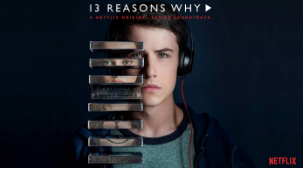13 Reasons Why

June 3, 2017
My friend next to me jokingly puts two fingers to her temple in a mock suicide attempt, responding to a essay assignment without a reasonable deadline. I replied, “Hello (insert teacher name), welcome to your tape.” I was fortunately welcomed by a chorus of laughter; however, suicide should not be made a laughing matter. The release of 13 Reasons Why is causing teens, parents, and even administrators to come to terms with how to face suicide.
The popular Netflix original show 13 Reasons Why explains in thirteen episodes, each dedicated to a different reason, why Hannah Baker killed herself. Hannah Baker leaves behind thirteen tapes, each calling out an individual, to explain how the were involved with her death. It explores how individuals cope with death, loss, and their teenager years. This show does a brilliant job of illuminating high school bureaucracy, sexual harassment, suicide, mental health, and bullying.
Several individuals have called out the show saying it dramatizes and encourages suicide. The show has been called a trigger for children to commit suicide.
Suicide prevention experts say it was a dangerous decision to release this show. Peer-reviewed research showed that suicide is “contagious”, and that suicide attempts go up after any graphic depiction of a successful suicide, whether fictional or otherwise. Victor Schwartz, a psychiatry professor at New York University and chief medical officer of the suicide prevention program the JED Foundation, claims, “Research shows us that the more obvious, florid, dramatic, and explicit the portrayal is there’s the potential that for some people who see it, who are really struggling with something, this winds up being in some way strangely appealing.”
The Directorial Staff of 13 Reasons Why tried to show a teen at rock bottom to depict how the painful, unpleasant, and messy really of suicide and allow the audience to empathize with a hypothetical suicidal teen. Aesthetically and artistically, most critics approved of the choice. “Looking away from what happened to her body would have felt false and evasive,” wrote Mo Ryan at Variety. “That haunting, spare scene of Hannah cutting her skin was shocking and unforgettable. It pressed a button, but not in a cheap, flashy way. It was a horrifying and very specific moment of consequence that touched the soul, and sometimes that’s how art works.” All in all the creation and death of Hannah Baker allowed us all to experience the emotional trauma of suicide.
Some school and parents have begun banning discussions of the show because of the mature subject matter and graphic depiction of Hannah Baker’s death. However, Radnor High School has used it as an opportunity to remind individuals about their mental health resources. Radnor High School has recently incorporated a tab on the main web page called “13 Reasons Why Resources.” On this page a series of links explaining the story of the show are given, how to talk to your child about suicide, mental health resources both on and off campus, suicide awareness information, and the guidance office’s contact information.
Most people were unsure if a second season of the show would even ever come into production, due to the mixed reviews covering both ends of the spectrum. Yet, roughly a week ago the producers announced that the second season was just drafted and it appears the show will be gaining a new narrator instead of Hannah. Thus leading many to believe that another tragedy will occur in the story line. Audiences are eagerly awaiting it’s release and wonder if the writing team has listened to any of the public’s feedback. Nevertheless, we will all be curious to see if the continuation of this show will do more harm than good, and maybe even lead other high schools to add “13 Reasons Why Resources” pages to their websites.






